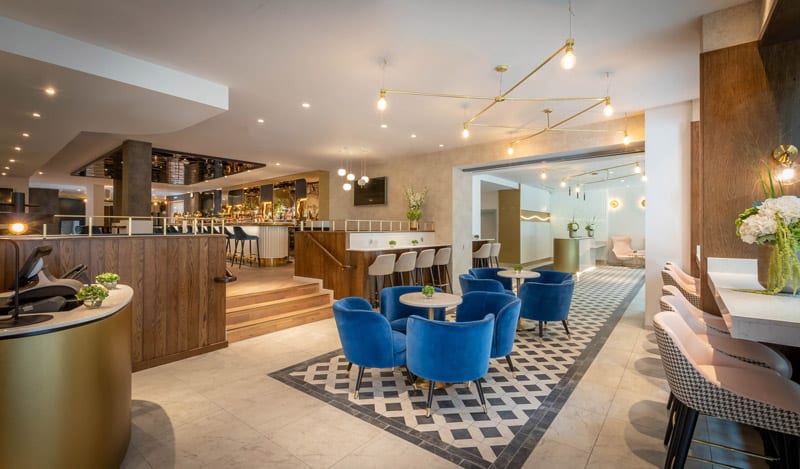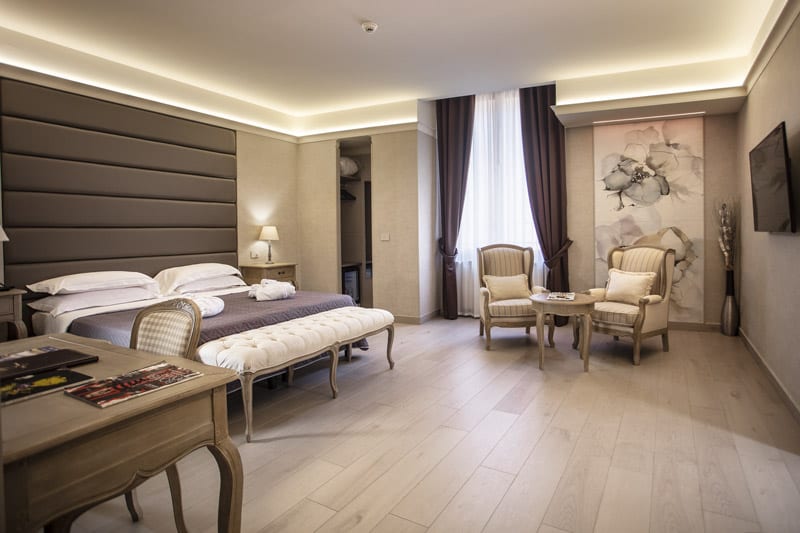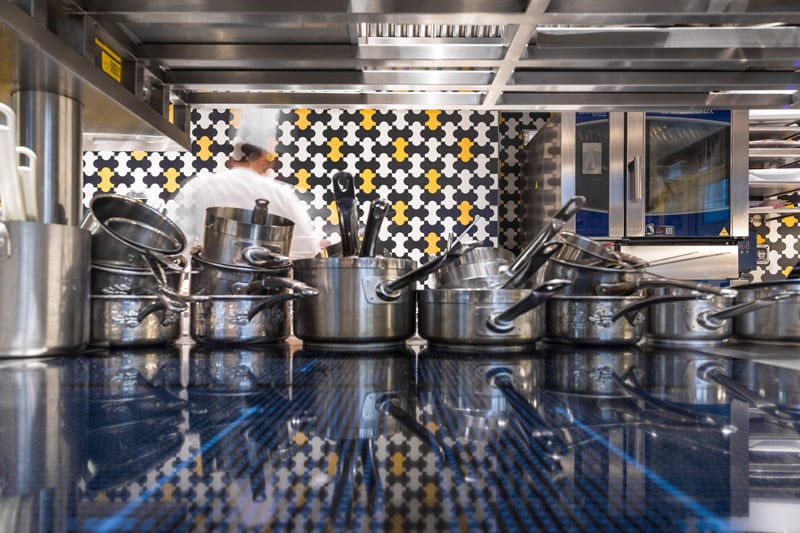Projects


The use of ceramic surfaces in hospitality spaces | by Juergen Mayer
Hotels, restaurants, bars – for many people these three words elicit positive feelings. They conjure up memories and emotions associated with good service and an enjoyable culinary experience in a stylish and relaxed setting. Atmosphere is the magic word! With almost no other type of project is this such a crucial factor.
Provided that service and quality are satisfactory, atmosphere is the factor that most determines the uniqueness of the experience. Hotels, restaurants and bars are leisure venues that offer an escape from normal life, whether in the city or in the mountains, by the lake or by the sea, for a long holiday or a short break, a city visit or a business trip. They are also places where guests from all over the world can meet and are increasingly envisaged as a kind of film set.
Creating a unique and unforgettable experience is the mission of the top hoteliers, restaurateurs and bar owners. It’s all about creating a unique sales proposition: a successful interior, a unique image and a striking exterior must be combined to create a coherent overall concept presented with a style that is determined by materials, colours, surfaces and light. Numerous projects all over the world have shown that porcelain is an excellent material for these design challenges, not just because it stands out for its quality, variety and aesthetics but also because it meets all functional and hygiene requirements. (see also the public hospitality facilities in the Projects Gallery).
Hotels: the lobby and restaurant
 IIn an increasingly virtual world, hotels, bars and restaurants are physical meeting places for people of different nationalities and backgrounds but with similar lifestyles. Atmosphere is particularly important in the lobby, the busiest area of hotels where people stop to talk and congregate.
IIn an increasingly virtual world, hotels, bars and restaurants are physical meeting places for people of different nationalities and backgrounds but with similar lifestyles. Atmosphere is particularly important in the lobby, the busiest area of hotels where people stop to talk and congregate.
Porcelain floor and wall tiles can play a key role in interior design projects. Thanks to the enormous variety of surfaces, textures, colours, decorations and relief structures, they offer huge creative potential. The range of possibilities stretches from full-body coloured surfaces with a matt finish through to original graphic and geometric designs that are not found in natural stone. Further options include decorations with a retro flavour, a used, timeworn look, metal effects and many different textures inspired by other materials such as interpretations of wood, leather, stone, carpets and fabrics, as well as three-dimensional surfaces that play with light and shadow effects. Porcelain can have such a high aesthetic impact that it can dictate the overall design of an interior, but at the same time it has the versatility necessary to adapt to the general concept.
Porcelain also has exceptional functional qualities as it is made from natural raw materials. In particular, it has a high density and is unbreakable, scratch resistant and resistant to corrosion and any type of dirt thanks to its very low porosity. Porcelain floors subject to intensive use by large numbers of guests and customers are easy to clean and resistant to the surfactants present in cleaning agents (also see: Ceramic characteristics).
Bars and restaurants can also benefit from the use of porcelain as a design element in spaces that offer an emotional experience. Thanks to the above-mentioned surface properties, it is possible to create rooms with a high level of uniformity in terms of the materials used on the walls, floors and even the surfaces of furniture. Extremely tough and lightweight porcelain panels with a thickness of just a few millimetres are ideal for use on bar counters, tabletops, doors, cabinets and drawers, as well as large cupboard and shelving elements and sliding doors for restaurants and kitchens.
In terms of acoustics, porcelain can make a valuable contribution to the comfort of a restaurant dining room. Even in very busy premises, guests expect to be able to communicate with each other. Coverings with relief surfaces absorb sound waves and reduce reverberation, thereby lowering the overall noise level.
For these applications, it’s certainly worth investing in premium quality, highly durable materials. If guests appreciate the atmosphere created by architects and interior designers, the digital multiplier effect automatically kicks in as enthusiastic users share their experiences on social media. Photogenic and Instagrammable locations are soon no longer shared secrets but viral experiences.

Hotel rooms and bathrooms
A quick glance is all it takes for a hotel guest to know whether or not they like a hotel room. As soon as the door opens, the expert inside every guest carefully evaluates the room. The ambience, level of comfort, layout, size and fittings, lighting and view are all appraised and analysed within a matter of seconds. And if everything goes well, this room – effectively a “temporary home” for hours, days or weeks – will pass the guest’s test in terms of materials, surfaces, light and colours.
Once again, slim, large-format porcelain surfaces can enhance spaces. Thanks to the use of large, thin panels, it is possible to create stunning wall coverings that extend from floor to ceiling, as well as full-height sliding doors for wardrobes and bathroom doors. The large sizes make even the smallest of rooms look bigger.
Minimalism certainly helps in the design of beautiful and relaxing bathrooms, but the same applies to wellness and spa areas in hotels. A more uniform, linear design produces less eyestrain and aids relaxation, an effect that can be enhanced using restrained, subtle materials and creativity, skilful lighting and views of nature.
The same principle holds true for the room furnishings. Porcelain not only stands out for its aesthetics, but with its durable, hygienic and easy-to-clean surfaces it is also ideal for establishments with high guest turnover rates. The larger the panels, the fewer joints there are and the easier it is to keep the surfaces in perfectly hygienic conditions. And because guest safety has top priority, in wet areas porcelain tiles with an appropriate slip resistance class may also be useful for windowless bathrooms with mechanical ventilation. Of course, porcelain tiles also offer many advantages in saunas, swimming pools and relaxation areas in hotels.
Hotel kitchens and bars
 However, it is not only bars and public areas that can benefit from the properties of porcelain, but also kitchens reserved for employees. In the backstage areas of restaurants and bars, this material really comes into its own for use on false ceilings and worktops. The main priorities are that the surfaces can be thoroughly cleaned and that they are resistant to heat, temperature changes, oils, greases and acids. As work in a kitchen is often hectic and intense, high impact resistance is also an advantage. Porcelain’s high density means that it is harder and more compact than natural stone, but unlike stone it can be produced in a wide range of colours to suit the mood of the project and the environment. Even behind the scenes in restaurants, design knows no limits!
However, it is not only bars and public areas that can benefit from the properties of porcelain, but also kitchens reserved for employees. In the backstage areas of restaurants and bars, this material really comes into its own for use on false ceilings and worktops. The main priorities are that the surfaces can be thoroughly cleaned and that they are resistant to heat, temperature changes, oils, greases and acids. As work in a kitchen is often hectic and intense, high impact resistance is also an advantage. Porcelain’s high density means that it is harder and more compact than natural stone, but unlike stone it can be produced in a wide range of colours to suit the mood of the project and the environment. Even behind the scenes in restaurants, design knows no limits!
For reasons of occupational safety, kitchen floors must be totally slip-resistant because cooking inevitably produces water vapour which subsequently condenses on surfaces. Porcelain tiles are available in special versions that guarantee an adequate grip, thus maintaining safety. Another major advantage is the fact that matt, low-refractivity surface finishes can facilitate the work of chefs and kitchen staff during food preparation and cooking as the absence of glare and reflections improves concentration and reduces fatigue.
Equally suitable for areas open to the public and for behind-the-scenes use in hotels, bars and restaurants, porcelain is a universal finishing material that offers solutions for virtually any application.
November 2020



